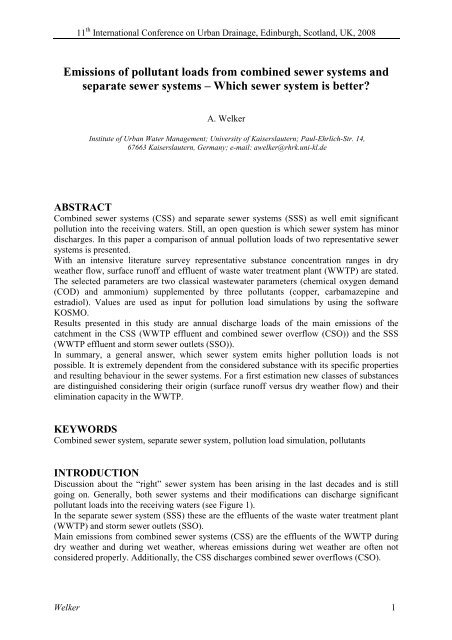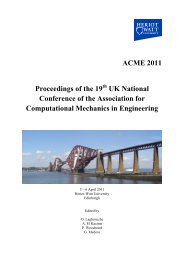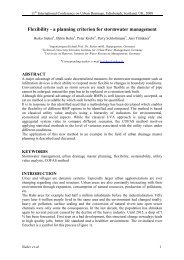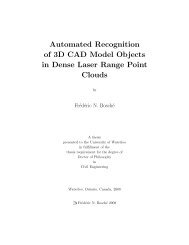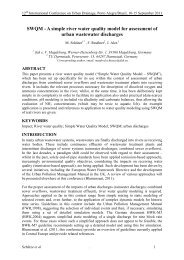Emissions of pollutant loads from combined sewer systems and ...
Emissions of pollutant loads from combined sewer systems and ...
Emissions of pollutant loads from combined sewer systems and ...
Create successful ePaper yourself
Turn your PDF publications into a flip-book with our unique Google optimized e-Paper software.
11 th International Conference on Urban Drainage, Edinburgh, Scotl<strong>and</strong>, UK, 2008<br />
<strong>Emissions</strong> <strong>of</strong> <strong>pollutant</strong> <strong>loads</strong> <strong>from</strong> <strong>combined</strong> <strong>sewer</strong> <strong>systems</strong> <strong>and</strong><br />
separate <strong>sewer</strong> <strong>systems</strong> – Which <strong>sewer</strong> system is better?<br />
A. Welker<br />
Institute <strong>of</strong> Urban Water Management; University <strong>of</strong> Kaiserslautern; Paul-Ehrlich-Str. 14,<br />
67663 Kaiserslautern, Germany; e-mail: awelker@rhrk.uni-kl.de<br />
ABSTRACT<br />
Combined <strong>sewer</strong> <strong>systems</strong> (CSS) <strong>and</strong> separate <strong>sewer</strong> <strong>systems</strong> (SSS) as well emit significant<br />
pollution into the receiving waters. Still, an open question is which <strong>sewer</strong> system has minor<br />
discharges. In this paper a comparison <strong>of</strong> annual pollution <strong>loads</strong> <strong>of</strong> two representative <strong>sewer</strong><br />
<strong>systems</strong> is presented.<br />
With an intensive literature survey representative substance concentration ranges in dry<br />
weather flow, surface run<strong>of</strong>f <strong>and</strong> effluent <strong>of</strong> waste water treatment plant (WWTP) are stated.<br />
The selected parameters are two classical wastewater parameters (chemical oxygen dem<strong>and</strong><br />
(COD) <strong>and</strong> ammonium) supplemented by three <strong>pollutant</strong>s (copper, carbamazepine <strong>and</strong><br />
estradiol). Values are used as input for pollution load simulations by using the s<strong>of</strong>tware<br />
KOSMO.<br />
Results presented in this study are annual discharge <strong>loads</strong> <strong>of</strong> the main emissions <strong>of</strong> the<br />
catchment in the CSS (WWTP effluent <strong>and</strong> <strong>combined</strong> <strong>sewer</strong> overflow (CSO)) <strong>and</strong> the SSS<br />
(WWTP effluent <strong>and</strong> storm <strong>sewer</strong> outlets (SSO)).<br />
In summary, a general answer, which <strong>sewer</strong> system emits higher pollution <strong>loads</strong> is not<br />
possible. It is extremely dependent <strong>from</strong> the considered substance with its specific properties<br />
<strong>and</strong> resulting behaviour in the <strong>sewer</strong> <strong>systems</strong>. For a first estimation new classes <strong>of</strong> substances<br />
are distinguished considering their origin (surface run<strong>of</strong>f versus dry weather flow) <strong>and</strong> their<br />
elimination capacity in the WWTP.<br />
KEYWORDS<br />
Combined <strong>sewer</strong> system, separate <strong>sewer</strong> system, pollution load simulation, <strong>pollutant</strong>s<br />
INTRODUCTION<br />
Discussion about the “right” <strong>sewer</strong> system has been arising in the last decades <strong>and</strong> is still<br />
going on. Generally, both <strong>sewer</strong> <strong>systems</strong> <strong>and</strong> their modifications can discharge significant<br />
<strong>pollutant</strong> <strong>loads</strong> into the receiving waters (see Figure 1).<br />
In the separate <strong>sewer</strong> system (SSS) these are the effluents <strong>of</strong> the waste water treatment plant<br />
(WWTP) <strong>and</strong> storm <strong>sewer</strong> outlets (SSO).<br />
Main emissions <strong>from</strong> <strong>combined</strong> <strong>sewer</strong> <strong>systems</strong> (CSS) are the effluents <strong>of</strong> the WWTP during<br />
dry weather <strong>and</strong> during wet weather, whereas emissions during wet weather are <strong>of</strong>ten not<br />
considered properly. Additionally, the CSS discharges <strong>combined</strong> <strong>sewer</strong> overflows (CSO).<br />
Welker 1
11 th International Conference on Urban Drainage, Edinburgh, Scotl<strong>and</strong>, UK, 2008<br />
separate <strong>sewer</strong> system<br />
paved area<br />
(ro<strong>of</strong>, streets etc.)<br />
surface run<strong>of</strong>f<br />
storm<br />
<strong>sewer</strong><br />
storm <strong>sewer</strong> flow<br />
treatment<br />
devices<br />
(if necessary)<br />
storm <strong>sewer</strong> outlets (SSO)<br />
receiving water<br />
households,<br />
commerce,<br />
industry<br />
dry weather flow<br />
<strong>combined</strong><br />
<strong>sewer</strong><br />
<strong>combined</strong> <strong>sewer</strong> flow<br />
CSO<br />
devices<br />
(e.g. stormtank)<br />
<strong>combined</strong> <strong>sewer</strong> overflow (CSO)<br />
<strong>combined</strong> <strong>sewer</strong> system<br />
water supply rainfall water supply<br />
rainfall<br />
households,<br />
commerce,<br />
industry<br />
dry weather flow<br />
sanitary<br />
<strong>sewer</strong><br />
inflow wwtp (dw)<br />
WWTP<br />
effluent WWTP (dw)<br />
inflow<br />
WWTP<br />
(dw, ww)<br />
paved area<br />
(ro<strong>of</strong>, streets etc.)<br />
surface run<strong>of</strong>f<br />
WWTP<br />
effluent WWTP (dw, ww)<br />
Figure 1. Pathways <strong>and</strong> emissions <strong>from</strong> separate <strong>sewer</strong> <strong>systems</strong> <strong>and</strong> <strong>combined</strong> <strong>sewer</strong> <strong>systems</strong>;<br />
WWTP: waster water treatment plant; ww: wet weather, dw: dry weather<br />
A second frequently discussed issue is the question, what are the right substance parameters to<br />
assess possible impacts <strong>of</strong> discharges <strong>from</strong> <strong>sewer</strong> <strong>systems</strong>? Up to now, <strong>of</strong>ten common<br />
wastewater parameters (e.g. suspended solids (SS) <strong>and</strong> chemical oxygen dem<strong>and</strong> (COD)) are<br />
regarded (de T<strong>of</strong>fol et al., 2007). The recently released European Community Water<br />
Framework Directive (WFD) considers further specific <strong>pollutant</strong>s (e.g. heavy metals,<br />
pesticides, polycyclic aromatic hydrocarbons (PAHs)) as priority substances for classifying<br />
the chemical status <strong>of</strong> receiving waters (EC, 2006). In Germany, emissions out <strong>of</strong> <strong>sewer</strong><br />
<strong>systems</strong> (SSS <strong>and</strong> CSS) have already been identified to be a significant source <strong>of</strong> receiving<br />
water pollution (Irmer, 2006). As a consequence, it becomes essential to extend the list <strong>of</strong><br />
considered parameters in <strong>sewer</strong> system discharges.<br />
Therefore, in this study five substance parameters were selected covering a representative<br />
range <strong>of</strong> individual substance properties. These properties are significant for occurrence <strong>and</strong><br />
fate <strong>of</strong> the substances at relevant emission points out <strong>of</strong> <strong>sewer</strong> <strong>systems</strong> (Welker, 2006).<br />
In order to assess which <strong>sewer</strong> system has minor pollution emissions to receiving waters it is<br />
important to decide which is the right decisive criterion. In this field two possibilities are<br />
under discussion: (a) long term criteria like annual emitted <strong>pollutant</strong> <strong>loads</strong>, which is the<br />
common procedure in Germany <strong>and</strong> (b) short term criteria like substance concentration<br />
values. The focal points <strong>of</strong> this paper are the relevant emitted pollution <strong>loads</strong> that are<br />
calculated with pollution load simulations.<br />
2 Welker
11 th International Conference on Urban Drainage, Edinburgh, Scotl<strong>and</strong>, UK, 2008<br />
METHODS<br />
Selection <strong>of</strong> <strong>pollutant</strong> parameters<br />
In a first step representative substance concentration ranges in dry weather flow, surface<br />
run<strong>of</strong>f <strong>and</strong> effluent <strong>of</strong> WWTP were stated summarizing reported field data (for details see<br />
Welker, 2004 <strong>and</strong> 2007). These values were used as input for pollution load simulations<br />
described below. The chosen parameters are two classical wastewater parameters (COD <strong>and</strong><br />
ammonium) supplemented by three <strong>pollutant</strong>s (copper (Cu), carbamazepine <strong>and</strong> estradiol<br />
(E2)) (see Table 1).<br />
Copper is a typical surface run<strong>of</strong>f derived compound that is efficiently removed in WWTPs.<br />
Carbamazepine is a human pharmaceutical, estradiol is a natural hormone. Both compounds<br />
derive exclusively <strong>from</strong> dry weather flows. Still, they have completely different elimination<br />
rates in the WWTP (estradiol: nearly 95 %; carbamazepine: nearly 0 %).<br />
Table 1. Substance concentrations in important flow types <strong>of</strong> the <strong>combined</strong> <strong>sewer</strong> system <strong>and</strong> the<br />
separate <strong>sewer</strong> system<br />
value COD NH4-N Cu carbamazepine<br />
E2<br />
[mg/l] [mg/l] [µg/l] [µg/l] [ng/l]<br />
dry weather flow 441 22 66 0.73 15<br />
surface run<strong>of</strong>f 107 1.0 116 < 0.02 * < 0.02 *<br />
effluent WWTP (dw) 66 2.0 13 0.73 0.8<br />
effluent WWTP (ww) ** 31 0.7 21 0.21 0.2<br />
references 1 2-4 2-5 2, 6-13 13-20<br />
dw: dry weather; ww: wet weather; COD: chemical oxygen dem<strong>and</strong>; NH 4-N: ammonium; E2: 17-β-estradiol; * calculation<br />
with 50 % <strong>of</strong> the lowest reported detection limit; ** calculated by a balance<br />
references: 1: House et al., 1993; 2: Welker, 2004; 3: Brombach et al., 2005; 4: Smullen et al., 1999; 5: Makepeace et al.,<br />
1995; 6: Thornton et al., 2001; 7: Reinhard et al., 2003; 8: Gross et al., 2004; 9: Webb, 2001; 10: Heberer, 2002; 11: Clara et<br />
al., 2005; 12: Joss et al., 2006; 13: Ternes et al., 2007; 14: Miege et al., 2007; 15: Birkett <strong>and</strong> Lester, 2003; 16: Spengler et<br />
al., 2001; 17: ATV-DVWK IG-5.4, 2002; 18: Schlüsener <strong>and</strong> Bester, 2005; 19: Svenson et al., 2007; 20: Johnson et al., 2005<br />
Pollution load simulations<br />
A representative <strong>and</strong> hypothetical catchment (187 ha) which was previously used for various<br />
theoretical studies in Germany was chosen for the simulation study (Welker et al., 1999). The<br />
catchment (9,900 inhabitants) has a total paved area <strong>of</strong> 98 ha <strong>and</strong> is drained by a <strong>combined</strong><br />
<strong>sewer</strong> system including two CSOs <strong>and</strong> two stormwater tanks (SWT) (for details see Welker,<br />
2006). Calculations for the separate <strong>sewer</strong> system were obtained by transferring the chosen<br />
catchment into a separate <strong>sewer</strong> system.<br />
For pollution load simulation the s<strong>of</strong>tware KOSMO (Kontinuierliche Schmutzfrachtmodellierung)<br />
has been used (Schmitt, 1993). KOSMO includes models for all relevant<br />
processes like surface pollution with an exponential accumulation <strong>and</strong> wash <strong>of</strong>f equation.<br />
Surface run<strong>of</strong>f <strong>and</strong> the corresponding <strong>sewer</strong> flow were computed with a hydrological method.<br />
The calculated annual water volumes are illustrated in Table 2.<br />
Welker 3
11 th International Conference on Urban Drainage, Edinburgh, Scotl<strong>and</strong>, UK, 2008<br />
Table 2. Calculated annual water volumes for both <strong>sewer</strong> <strong>systems</strong><br />
[m³/year] <strong>combined</strong><br />
separate<br />
<strong>sewer</strong> system <strong>sewer</strong> system<br />
surface run<strong>of</strong>f 570,478 570,478<br />
urban drainage emissions 189,538 * 570,478 **<br />
effluent WWTP wet weather 556,551 -<br />
effluent WWTP dry weather 1,197,768 1,373,379<br />
effluent WWTP total 1,754,319 1,373,379<br />
total 1,943,857 1,943,857<br />
* <strong>combined</strong> <strong>sewer</strong> overflow (CSO); ** storm <strong>sewer</strong> outlets (SSO)<br />
RESULTS AND DISCUSSION<br />
Results come out with annual discharge <strong>loads</strong> <strong>of</strong> the main emissions <strong>of</strong> the two hypothetical<br />
catchments in the CSS (WWTP effluent <strong>and</strong> CSO) <strong>and</strong> the SSS (WWTP effluent <strong>and</strong> SSO)<br />
<strong>and</strong> are illustrated in Figure 2, 3 <strong>and</strong> 4.<br />
The results show that <strong>pollutant</strong> emissions <strong>from</strong> the two observed <strong>sewer</strong> <strong>systems</strong> (CSS versus<br />
SSS) vary significantly dependent on the considered parameter <strong>and</strong> its specific properties.<br />
Simulations for the present state<br />
Waste water parameters COD <strong>and</strong> ammonium<br />
Figure 2 shows the results for the waste water parameters COD <strong>and</strong> ammonium.<br />
In the case <strong>of</strong> ammonium total emissions <strong>from</strong> both <strong>sewer</strong> <strong>systems</strong> are in the same range.<br />
Since ammonium is predominately derived <strong>from</strong> the dry weather flow, proportion <strong>of</strong><br />
discharges results by surface run<strong>of</strong>f (CSS: CSO <strong>and</strong> in SSS: SSO) in both system is very low.<br />
Dominant are ammonium discharges <strong>from</strong> the WWTP during dry weather (grey bars).<br />
For COD the SSS emits a higher amount than the CSS. In comparison to ammonium COD is<br />
a significant compound <strong>of</strong> surface run<strong>of</strong>f <strong>and</strong> dry weather flow. Therefore in the SSS the<br />
proportion <strong>of</strong> surface water related emissions has a higher relevance <strong>and</strong> is emitted mostly<br />
untreated into the receiving waters. This results in high annual <strong>loads</strong> <strong>of</strong> COD in the storm<br />
<strong>sewer</strong> outlets (black bar). In the CSS these fractions are partly treated in WWTP where the<br />
elimination rate is very effective. This leads to comparable lower emissions out <strong>of</strong> the CSO<br />
(black bar) <strong>and</strong> therefore reduced total emissions.<br />
4 Welker
11 th International Conference on Urban Drainage, Edinburgh, Scotl<strong>and</strong>, UK, 2008<br />
160000<br />
140000<br />
120000<br />
100000<br />
80000<br />
60000<br />
40000<br />
20000<br />
0<br />
WWTP (dw)<br />
WWTP (ww)<br />
CSO or SSO<br />
COD CSS COD SSS NH4 CSS NH4 SSS<br />
Figure 2. Emitted <strong>loads</strong> <strong>of</strong> COD [kg/year] <strong>and</strong> ammonium (NH4) [kg *10/year] calculated by<br />
pollution load simulations<br />
WWTP (dw): effluent WWTP dry weather; WWTP (ww): effluent WWTP wet weather; CSO: <strong>combined</strong> <strong>sewer</strong> overflow; SSO: storm <strong>sewer</strong> outlets; CSS:<br />
<strong>combined</strong> <strong>sewer</strong> system; SSS: separate <strong>sewer</strong> system<br />
Selected <strong>pollutant</strong>s copper, carbamazepine <strong>and</strong> estradiol<br />
Looking at the results <strong>of</strong> the three selected <strong>pollutant</strong>s similar effects can be observed (Figure<br />
3).<br />
Copper is a dominant component <strong>of</strong> surface run<strong>of</strong>f <strong>and</strong> therefore occurs in significant amounts<br />
in the surface run<strong>of</strong>f related compounds in both <strong>systems</strong> (black bars: CSO <strong>and</strong> SSO).<br />
Comparing the <strong>sewer</strong> <strong>systems</strong> the CSS is clearly favourable for the receiving waters<br />
demonstrated by significant lower total annual <strong>loads</strong> in relation to the SSS. The reasons for<br />
this behaviour are similar to the effects discussed for the parameter COD (see above).<br />
Exclusively dry weather flow derived substances show a differing picture. In both <strong>sewer</strong><br />
<strong>systems</strong> surface run<strong>of</strong>f related emissions (black bars: CSO <strong>and</strong> SSO) have a minor importance<br />
in comparison to copper with the exception <strong>of</strong> estradiol (see below).<br />
Comparing estradiol <strong>and</strong> carbamazepine, the distribution <strong>of</strong> annual <strong>loads</strong> especially in the<br />
CSS is differing. In case <strong>of</strong> estradiol, the proportion <strong>of</strong> annual CSO load is significant higher<br />
than in the case <strong>of</strong> carbamazepine. This effect is mainly caused by the different elimination<br />
rate <strong>of</strong> the substances in the WWTP (estradiol: nearly 95 %; carbamazepine: nearly 0 %).<br />
Substances like estradiol can be eliminated in a WWTP to a higher extent in comparison to<br />
the drainage system because the treatment in the WWTP provides retention time <strong>of</strong> hours to<br />
days. In contrast, in the <strong>sewer</strong> system the retention time is <strong>of</strong>ten less than 60 min.<br />
This is not relevant for the compound carbamazepine. Since it is not eliminated neither in the<br />
drainage system nor in the WWTP total emissions in both <strong>sewer</strong> system are in the same range.<br />
Clearly dominant are the emissions <strong>of</strong> the WWTP during dry weather. For estradiol <strong>and</strong><br />
substances with analogous properties total emissions out <strong>of</strong> a <strong>combined</strong> <strong>sewer</strong> system are<br />
significant higher than out <strong>of</strong> a separate <strong>sewer</strong> system.<br />
Welker 5
140000<br />
120000<br />
100000<br />
80000<br />
60000<br />
40000<br />
20000<br />
11 th International Conference on Urban Drainage, Edinburgh, Scotl<strong>and</strong>, UK, 2008<br />
0<br />
WWTP dw<br />
WWTP ww<br />
CSO or SSO<br />
Cu CSS Cu SSS carb CSS carb SSS E2 CSS E2 SSS<br />
Figure 3. Emitted <strong>loads</strong> <strong>of</strong> copper (Cu) [g/year], carbamazepine (carb) [mg/10/year] <strong>and</strong><br />
estradiol (E2) [mg*10/year] calculated by pollution load simulations<br />
WWTP (dw): effluent WWTP dry weather; WWTP (ww): effluent WWTP wet weather; CSO: <strong>combined</strong> <strong>sewer</strong> overflow; SSO: storm <strong>sewer</strong> outlets; CSS:<br />
<strong>combined</strong> <strong>sewer</strong> system; SSS: separate <strong>sewer</strong> system<br />
Disconnection <strong>of</strong> paved areas<br />
A common measure to reduce emissions <strong>from</strong> urban drainage <strong>systems</strong> is the disconnection <strong>of</strong><br />
paved areas <strong>from</strong> the drainage system. This is especially true for low contaminated flow types<br />
like ro<strong>of</strong> run<strong>of</strong>f <strong>and</strong> run<strong>of</strong>fs <strong>from</strong> street areas with a low traffic density. These flow types are<br />
<strong>of</strong>ten infiltrated to the groundwater by several devices (e.g. trenches).<br />
Exclusively by the example <strong>of</strong> the chosen hypothetical separate <strong>sewer</strong> system 25 % <strong>of</strong> the<br />
paved areas were disconnected, demonstrated in Figure 4 for the surface run<strong>of</strong>f derived<br />
parameters COD <strong>and</strong> copper. This value certainly represents an upper limit in existing<br />
<strong>systems</strong>. Within, the annual pollution <strong>loads</strong> infiltrated into the soil groundwater system are<br />
illustrated as white bars.<br />
Results for COD <strong>and</strong> copper clearly show, that even a significant disconnection <strong>of</strong> paved<br />
areas leads to dominant total emissions resulted <strong>from</strong> the separate <strong>sewer</strong> system. Therefore,<br />
also under these conditions, total emissions to the receiving waters <strong>from</strong> the <strong>combined</strong> <strong>sewer</strong><br />
system are significant lower in relation to a separate <strong>sewer</strong> system.<br />
6 Welker
11 th International Conference on Urban Drainage, Edinburgh, Scotl<strong>and</strong>, UK, 2008<br />
160000<br />
140000<br />
120000<br />
100000<br />
80000<br />
60000<br />
40000<br />
20000<br />
0<br />
infiltration <strong>loads</strong><br />
WWTP (dw)<br />
WWTP (ww)<br />
CSO or SSO<br />
COD CSS COD SSS Cu CSS Cu SSS<br />
Figure 4. Emitted <strong>loads</strong> <strong>of</strong> COD [kg/year] <strong>and</strong> copper (Cu) [g/year] calculated by pollution<br />
load simulations for a disconnection <strong>of</strong> paved area <strong>of</strong> 25 %<br />
WWTP (dw): effluent WWTP dry weather; WWTP (ww): effluent WWTP wet weather; CSO: <strong>combined</strong> <strong>sewer</strong> overflow; SSO: storm <strong>sewer</strong> outlets; CSS:<br />
<strong>combined</strong> <strong>sewer</strong> system; SSS: separate <strong>sewer</strong> system<br />
Summary <strong>of</strong> results<br />
An estimation on the distribution <strong>of</strong> the emissions <strong>from</strong> <strong>sewer</strong> <strong>systems</strong> <strong>and</strong> a comparison<br />
between a <strong>combined</strong> <strong>and</strong> a separate <strong>sewer</strong> system needs information about the predominately<br />
origin (surface run<strong>of</strong>f, dry weather flow) <strong>and</strong> the elimination rate in the WWTP.<br />
Three classes <strong>of</strong> substances with certain properties can be distinguished:<br />
(1) surface run<strong>of</strong>f derived substances with a high elimination rate in the WWTP<br />
(copper <strong>and</strong> other substances e.g. heavy metals or PAHs): Substances with these<br />
properties generally show significant emissions in both <strong>systems</strong> <strong>from</strong> the run<strong>of</strong>f<br />
related flows (CSS: CSO versus SSS: SSO). Comparing the <strong>sewer</strong> <strong>systems</strong>, the SSS<br />
emits higher substance <strong>loads</strong> than the CSS since these substances are eliminated in<br />
the WWTP to a very high extent <strong>and</strong> stormwater run<strong>of</strong>fs are usually not treated<br />
properly.<br />
(2) dry weather flow derived substances with a low elimination rate in the WWTP<br />
as the chosen carbamazepine <strong>and</strong> other substances e.g. EDTA: Here the effluents out<br />
<strong>of</strong> the WWTP, especially during dry weather, are significant. Measures to reduce<br />
these emissions should therefore concentrate on the WWTP. Differences between<br />
the <strong>sewer</strong> <strong>systems</strong> are not important for this substance group.<br />
(3) dry weather flow derived substances with a high elimination rate in the WWTP<br />
as the considered estradiol <strong>and</strong> other substances e.g. NTA or ibupr<strong>of</strong>en: In contrast<br />
to substances <strong>from</strong> class 1, total emissions <strong>from</strong> the CSS are much higher than <strong>from</strong><br />
the SSS due to significant emissions at the CSO. This effect is a new aspect for<br />
exclusively dry weather flow derived substances.<br />
Welker 7
11 th International Conference on Urban Drainage, Edinburgh, Scotl<strong>and</strong>, UK, 2008<br />
CONCLUSIONS<br />
In conclusion, a general answer, which <strong>sewer</strong> system emits higher pollution <strong>loads</strong> is not<br />
possible. It is extremely dependent <strong>from</strong> the considered substance with its specific properties<br />
<strong>and</strong> resulting behaviour in the <strong>sewer</strong> <strong>systems</strong>. Therefore it is necessary to define<br />
representative decisive criteria for receiving water impairment including a definition <strong>of</strong> the<br />
relevant substance parameters.<br />
Results <strong>of</strong> the pollution load simulation for the <strong>combined</strong> <strong>sewer</strong> system show that emissions<br />
<strong>from</strong> CSOs are significant for certain substance parameters. This finding applies especially to<br />
contaminants that are removed efficiently WWTP, such as estradiol. In this cases reduction<br />
measures should consider discharges out <strong>of</strong> the WWTP <strong>and</strong> the CSO.<br />
Nonetheless, is important to extend the data base on the amount <strong>of</strong> substances, especially<br />
organic <strong>pollutant</strong>s in order to verify these first calculated results. These measurements are<br />
strongly recommended for the <strong>combined</strong> <strong>sewer</strong> system <strong>and</strong> for the CSOs in particular. Beside<br />
<strong>of</strong> the introduced substances further compounds (e.g. surfactants, other substances out <strong>of</strong><br />
personal care products, further pharmaceuticals, herbicides, flame retardants) should be taken<br />
into account.<br />
REFERENCES<br />
ATV-DVWK IG-5.4 (2002). Endokrin wirksame Substanzen in Kläranlagen – Vorkommen, Verbleib und<br />
Wirkung. (Endocrine disruptors in waste water treatment plants – occurrence, distribution <strong>and</strong> effects).<br />
Working document <strong>of</strong> the working group IG-5.4 <strong>from</strong> the German Water Association, DWA, Hennef,<br />
Germany.<br />
Birkett, J.W.; Lester, J.N. (2003). Endocrine Disruptors in Wastewater <strong>and</strong> Sludge Treatment Processes. Lewis<br />
Publishers, CRC Press, Florida, USA.<br />
Brombach, H.; Weiss, G.; Fuchs, S. (2005). A new database on urban run<strong>of</strong>f pollution: comparison <strong>of</strong> separate<br />
<strong>and</strong> <strong>combined</strong> <strong>sewer</strong> <strong>systems</strong>. Wat. Sci. Tech., 51, (2), 119-128.<br />
Clara, M.; Strenn, B.; Gans, O.; Martinez, E.; Kreuzinger, N.; Kroiss, H. (2005). Removal <strong>of</strong> selected<br />
pharmaceuticals, fragrances <strong>and</strong> endocrine disrupting compounds in a membrane bioreactor <strong>and</strong><br />
conventional wastewater treatment plants. Water Research, 39, (19), 4,797-4,807.<br />
EC (European Commission) (2006). Proposal for a directive <strong>of</strong> the European parliament <strong>and</strong> <strong>of</strong> the council on<br />
environmental quality st<strong>and</strong>ards in the field <strong>of</strong> water policy <strong>and</strong> amending directive 2000/60/EC.<br />
Gross, B; Montgomery-Brown, J; Naumann, A; Reinhard, M (2004). Occurrence <strong>and</strong> fate <strong>of</strong> pharmaceuticals<br />
<strong>and</strong> alkylphenol ethoxylate metabolites in an effluent-dominated river <strong>and</strong> wetl<strong>and</strong>. Environmental<br />
Toxicology <strong>and</strong> Chemistry, 23, (9), 2,074-2,083.<br />
Heberer, T. (2002). Occurrence, fate, <strong>and</strong> removal <strong>of</strong> pharmaceutical residues in the aquatic environment, a<br />
review <strong>of</strong> recent research data. Toxicology Letters, 131, 5-17.<br />
House, M.A.; Ellis, J.B.; Herricks, E.E.; Hvitved-Jacobsen, T.; Seager, J.; Lijklema, L.; Aalderink, H.; Clifforde,<br />
I.T. (1993). Urban drainage - impacts on receiving water quality. Wat. Sci. Tech., 27, (12), 117-158.<br />
Irmer, H. (2006). Chemische Gewässerindikatoren – Prioritäre St<strong>of</strong>fe – Defizite – H<strong>and</strong>lungsbedarf (quality<br />
indicators <strong>of</strong> receiving waters – priority substances – deficits – measures). Workshop <strong>of</strong> the Federal<br />
Environment Agency on the Water Framework Directive held in May 2006 in Berlin, Germany.<br />
Johnson, A.C.; Aerni, H.-R.; Gerritsen, A.; Gibert, M.; Giger, W.; Hyll<strong>and</strong>, K.; Jürgens, M.; Nakari, T.;<br />
Pickering, A.; Suter, M.J.-F.; Svenson, A.; Wettstein, F.E. (2005). Comparing steroid estrogen, <strong>and</strong><br />
nonylphenol content across a range <strong>of</strong> European sewage plants with different treatment <strong>and</strong><br />
management practices. Water Research, 39, (1), 47-58.<br />
Joss, A.; Zabczynski, S.; Göbel, A.; H<strong>of</strong>fmann, B.; Löffler, D.; McArdell, C.S.; Ternes, T.; Thomson, A.;<br />
Siegrist, H. (2006). Biological degradation <strong>of</strong> pharmaceuticals in municipal wastewater treatment:<br />
proposing a classification scheme. Water Research, 40, (8), 1,686-1,696.<br />
Makepeace, D.K.; Smith, D.W.; Stanley, S.J. (1995). Urban stormwater quality: Summary <strong>of</strong> contaminant data.<br />
Critical Reviews in Environmental Science <strong>and</strong> Technology, 25, (2), 93-139.<br />
8 Welker
11 th International Conference on Urban Drainage, Edinburgh, Scotl<strong>and</strong>, UK, 2008<br />
Miege, C.; Choubert, J.M.; Ribeiro, L.; Eusebe, M.; Coquery, M. (2007). Removal efficiency <strong>of</strong> pharmaceuticals<br />
<strong>and</strong> personal care products with varying wastewater treatment processes <strong>and</strong> operating conditions –<br />
Conception <strong>of</strong> a database <strong>and</strong> first results. Proceedings <strong>of</strong> the MICROPOL & ECOHAZRD Conference,<br />
Frankfurt, Germany, 220-226.<br />
Reinhard, M.; Montgomery-Brown, J.; Louie, J.S.; Gross, B. (2003). From effluent to new water: Performance<br />
evaluation <strong>and</strong> quality assurance. Chimia, 57, 561-566.<br />
Schlüsener, M.P.; Bester, K.: (2005). Determination <strong>of</strong> steroid hormones, hormone conjugates <strong>and</strong> macrolide<br />
antibiotics in influents <strong>and</strong> effluents <strong>of</strong> sewage treatment plants utilising high-performance liquid<br />
chromatography/t<strong>and</strong>em mass spectrometry with electrospray <strong>and</strong> atmospheric pressure chemical<br />
isolation. Rapid Communications in Mass Spectrometry, 19, 3,269-3,278<br />
Schmitt, T.G. (1993). Detailed <strong>combined</strong> overflow simulation regarding new German guidelines A 128. Proc.<br />
5th Conf. Urban Drainage Systems, Niagara Falls, Canada, 1,260-1,275.<br />
Smullen, J.T.; Shallcross, A.L.; Cave, K.A. (1999). Updating the U.S. Nationwide Urban Run<strong>of</strong>f Quality Data<br />
Base. Wat. Sci. Tech., 39, (12), 9-16.<br />
Spengler, P.; Körner, W.; Metzger, J.W. (2001). Substances with estrogenic activity in effluents <strong>of</strong> sewage<br />
treatment plants in southwestern Germany. 1. Chemical analysis. Environmental Toxicology <strong>and</strong><br />
Chemistry, 20, (10), 2,133-2,141.<br />
Svenson, A.; Allard, A.-S.; Ek, M. (2003). Removal <strong>of</strong> estrogenicity in Swedish municipal sewage treatment<br />
plants. Water Research, 37, (18), 4,433-4,443.<br />
Ternes, T.A.; Bonerz, M.; Herrmann, N.; Teiser, B.; Andersen, H.R. (2007). Irrigation <strong>of</strong> treated wastewater in<br />
Braunschweig, Germany: an option to remove pharmaceuticals <strong>and</strong> musk fragrances. Chemosphere, 66,<br />
(5), 894-904.<br />
Thornton, I.; Butler, D.; Docw, P.; Hesison, M.; Makropoulous, C.; McMullen, M.; Nieuwenhusjen, M.; Pitman,<br />
A.; Rautiu, R.; Sawyer, R.; Smith, S.; White, D.; Wilderer, P.; Paris, S.; Marani, D.; Braguglia, C.;<br />
Palerm, J. (2001). Pollutants in Urban Waste Water <strong>and</strong> Sewage Sludge. European Communities.<br />
Luxembourg, Office for Official Publications <strong>of</strong> the European Communities.<br />
T<strong>of</strong>fol de, S.; Engelhard, C.; Rauch, W. (2007). Combined <strong>sewer</strong> system versus separate system – a comparison<br />
<strong>of</strong> ecological <strong>and</strong> economical performance indicators. Wat. Sci. Tech., 55, (4), 255-264.<br />
Webb, S.F. (2001). A data-based perspective on the environmental risk assessment <strong>of</strong> human pharmaceuticals III<br />
- indirect human exposure. In: Kümmerer, K.: Pharmaceuticals in the Environment, Springer Verlag,<br />
Germany, 221-230.<br />
Welker, A.; Leinweber, U.; Klepiszewski, K., Schmitt, T.G. (1999). Effects <strong>of</strong> integrated stormwater<br />
management strategies on the <strong>combined</strong> <strong>sewer</strong> system <strong>and</strong> the wastewater treatment plant-river system.<br />
Wat. Sci. Tech., 39, (2), 151-157.<br />
Welker, A. (2004). Schadst<strong>of</strong>fströme im urbanen Wasserkreislauf – Aufkommen und Verteilung, insbesondere<br />
in den Abwasserentsorgungssystemen (Pollutant flows in the urban water cycle – fate <strong>and</strong> distribution,<br />
particulary in waste water <strong>systems</strong>). Postdoctoral lecture thesis, Institute <strong>of</strong> Environmental Engineering,<br />
Vol. 20, University <strong>of</strong> Kaiserslautern, Germany.<br />
Welker, A. (2006). First estimation <strong>of</strong> occurrence <strong>and</strong> fate <strong>of</strong> organic substances in <strong>combined</strong> <strong>sewer</strong> <strong>systems</strong> with<br />
pollution load simulations. Wat. Prac. Tech., wpt.2007.0041.<br />
Welker, A. (2007). Assessment <strong>of</strong> organic <strong>pollutant</strong>s with respect to occurrence <strong>and</strong> fate in <strong>combined</strong> <strong>sewer</strong><br />
<strong>systems</strong> <strong>and</strong> possible impacts on receiving waters. Wat. Sci. Tech., 56, (10), 141-148.<br />
Welker 9


